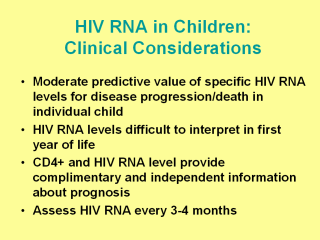| front |1 |2 |3 |4 |5 |6 |7 |8 |9 |10 |11 |12 |13 |14 |15 |16 |17 |18 |19 |20 |21 |22 |23 |24 |25 |26 |27 |28 |29 |review |
 |
Despite data indicating that high RNA levels
are associated with disease progression, the predictive value of specific
HIV RNA levels for disease progression and death for an individual child is
moderate (50, 83). HIV RNA levels may be difficult to interpret during the first year of life because levels are high and there is marked overlap in levels between children who have and those who do not have rapid disease progression (27, 47). Additional data indicate that CD4+ T cell percentage and HIV RNA copy number at baseline and changes in these parameters over time assist in determining the mortality risk in infected children, and the use of the two markers together may more accurately define prognosis (50, 51). Similar data and conclusions recently have been reported from several studies involving infected adults (52–54). HIV RNA and CD4+ percentage provide complementary and independent information about prognosis for HIV-infected children (Slide 16). Measurement of HIV RNA levels, like CD4+ percentage, is an important component of care for HIV-infected infants and children. HIV RNA copy number should be assessed as soon as possible after a child has a positive virologic test for HIV and every three to four months thereafter; Increased frequency of evaluations may be needed for children experiencing virologic or clinical deterioration, to confirm an abnormal value, or when initiating or changing antiretroviral therapy (see section “Virologic Considerations for Changing Therapy” in the Guidelines). |